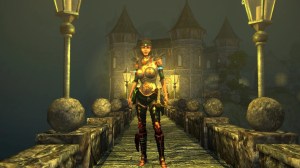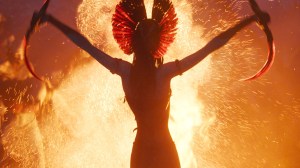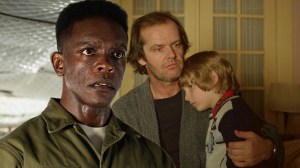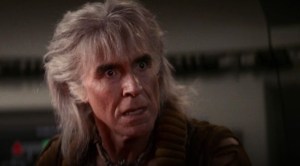
Writer Brian Wood returns to a familiar setting for his latest Dark Horse Comics series, Sword Daughter, with artist Mack Chater. The series’ start isn’t exactly the most graceful, but there’s an underlying depth that seems likely to bear fruit in the future.
Videos by ComicBook.com
Sword Daughter takes place during the Viking era in Europe and follows Elsbeth and her father, Dag. Elsbeth’s mother and brother were killed by a thuggish clan of warriors called the 40 Swords when they razed the town the family lived in. Dag fell into a decade-long stupor. Elsbeth grew up, survived, and made sure her father didn’t die. The day when the 12-year-old Elsbeth reaches for the sword on her father’s belt is the day Dag finally wakes up and begins his quest for revenge.
The influence of classic samurai stories like Lone Wolf and Cub is immediately apparent as the, but Sword Daughter also fits into a recent trend in fiction we’ll call “murder girls,” stories that involve young girls who suffered trauma and channel that trauma into acts of violence. See also: Hit-Girl, Hanna, Eleven, Laura.

Elsbeth certainly fits into this mold. In fact, the child is presented as nearly feral and even more inclined towards violence than her father. What separates Sword Daughter from most others in this subgenre is that its presentation is more grounded. Most murder girl stories lean into the dissonance of seeing a 12-year-old girl commit acts of bodily harm with a stylized presentation. The violence here should evoke a visceral response but is not presented in a way that distracts from the brutality. Chater and Wood want you to linger and consider.
Sword Daughter seems less interested in the violence itself than in the way it shapes the relationship between Elsbeth and Dag, who is hardly the model father. Dag is obsessed with wiping out the 40 Swords to the point that his first instinct is to leave Elsbeth behind, essentially abandoning her for the second time. Revenge is a familiar motivator, but the comic has its own texture and tone that can largely be credited to Chater’s art, as well as Jose Villarrubia’s colors. Villarrubia brings an earth-tone palette to most of the issue that speaks to the hard, rigorous, but rewarding life of the people on the island and serves as a great contrast to the black and crimson used whenever the 40 Swords are on the page, communicating the violence inherent in their being.
While the issue itself builds a strong foundation for the series, it suffers from some clumsy storytelling. Chater’s characters and expressions are mostly solid, but some of the frightened victims of the 40 Swords have expressions so over-the-top that they verge on comical, undercutting the horror of the scene.
There are also some missed opportunities in how certain moments are framed. At one point, a friend implies to Dag that he only survived his 10 sleeping years because Elsbeth looked after him, saying “Who do you think looked after you?” Setting aside this assertions’ plausibility and how casually Dag’s friend accepts his sudden reanimation, the moment feels like it calls for a shot of Elsbeth or a close-up of Dag’s reaction, but instead, we get a half-page mid-range shot of the conversation from a distance that illuminates and emphasizes nothing.
In other instances, Chater gets the scene perfectly, such as how he frames the moment that Dag tries to assert his paternal authority over Elsbeth, coming in close and looking up at Dag with his face covered in shadow.
Similarly, Sword Daughter takes an interesting approach to Elsbeth’s speech, but it’s unclear what the issue is trying to accomplish. Her word balloons have pictograms in them rather than words, which is a creative way to show how she has not learned to speak the way others do and is executed well by letterer Nate Piekos. However, despite the visual difference in language, her father seems to understand everything she’s saying just fine, even when there’s little to no context to aid him, making it unclear if this method is meant to represent a difference in vocabulary or tone, and its made even less clear since Elsbeth narrates the issue in perfect English.
Sword Daughter feels very much like a pilot issue. The issue is seemingly unsure of what it’s trying to accomplish in certain aspects, and takes a few clumsy steps for the sake reaching the story’s true launching pad by the end of the issue, but there’s a strength in the concept here seems likely to find surer footing now that the introductions are out of the way. If you’re a fan of Wood’s past Viking-era dramas like Northlanders and Black Road, or even his Revolutionary War series Rebels, Sword Daughter is the spiritual successor you’ve been waiting for.
Published by Dark Horse Comics
On January 6, 2018
Written by Brian Wood
Art by Mack Chater
Colors by Jose Villarrubia








